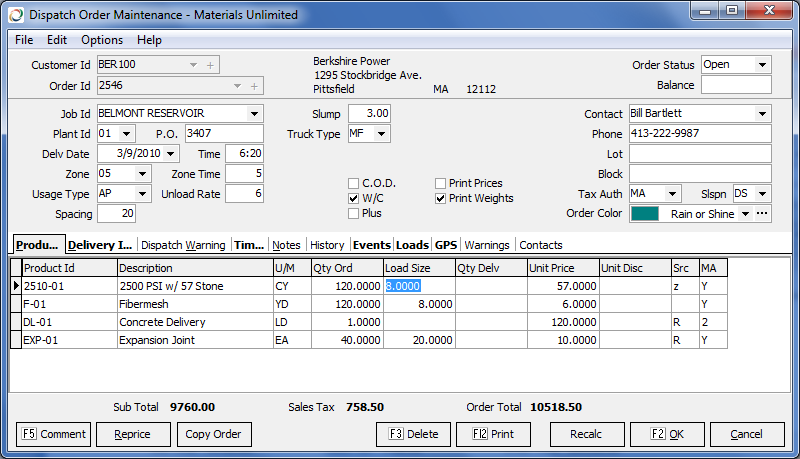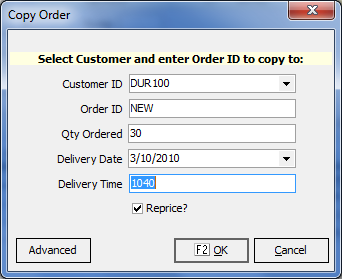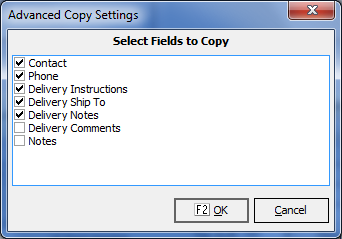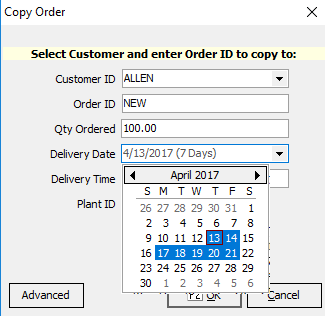Dispatch Order Maintenance
- Dispatch
Contents
About This Program
Using This Program
NOTE: In Keystone version 2.3.4, the presentation and handling of Load Size has been moved from the Order Body into the detail grid. This will provide a more logical way to setup orders and more control over the additionsl products on an order.
Main Order Data Fields
- Plant Id: The primary delivery plant is specified in this field. Other plants may be used to dispatch this order as well.
- P.O.: Purchase Order numbers should be entered here. Note: If a specially-priced job has a PO assigned, this number will automatically be assigned when the Job Id is specified. This field can also be used for Lot #’s for customers desiring separate invoices for each lot within a development.
- Delv. Date: Enter the delivery date in this field. Delivery Dates can be entered for today or any point in the future. Any attempt to date an order in the past will generate a warning.
- Time: Enter the first on-site time for this order. Keystone Dispatch will automatically calculate the batch time based on other fields entered later. The time field uses military time (eg: 3:00pm is 1500), and should be entered as a number without any punctuation.
- Zone: This field indicates the delivery zone for the order.
- Zone Time: This field receives its default value from the entry made in the Zone field, however may be overridden.
- Usage Type: The type of pour greatly influences the time an order requires. Usage Type indicates the type of pour, and builds the discharge rate into the time estimations.
- Unload Time: This field receives its default value from the entry made in Usage Type, however may be overridden.
- Spacing: This value represents how often a new should be sent to the job. If this field is left blank, Keystone Dispatch will adopt a one-at-a-time dispatch schedule, only sending out a truck when the last truck returned.
- Slump: If a specific slump is required, or needs to be printed, enter the slump here.
- Truck Type: For plants with both front and rear discharge mixers, this field can be used to specify a preferred mixer type.
- Order Status: Open is the default order status for any current order.
- Closed orders are orders which will not receive any more loads.
- Completed status is assigned by End-Of-Day processing when an order’s delivered quantity matches or exceeds the ordered quantity.
- Cancelled status is for orders which are cancelled prior to receiving any material.
- Hold status represents orders which are not currently shipping, but are expected to resume.
- C.O.D.: The COD flag is automatically set for any COD customers. This automatically triggers the printing of prices on the delivery ticket. In addition, these delivery tickets will not be subject to office re-pricing.
- Plus: When an order ships enough material to match the quantity ordered, it is no longer displayed on the order stack. By flagging an order as a plus order, it indicates that the quantity ordered is more of an estimate, and these orders will remain on the schedule.
- W/C: This field is used to indicate WILL CALL orders. Will Call orders appear on the schedule screen with a status indicating that it is not a firm order.
- Roll Forward: Most orders entered into Keystone Dispatch are for a single day. At the end of the day, even if not completed, the orders disappear from the schedule screen. Roll Forward orders stay on the schedule screen until their delivery quantity is met, whether that takes an extra day or an extra month.
- Print Prices: Checking this box triggers the printing of prices on the delivery ticket. Note: Some installations are set to automatically print prices on all tickets.
- Print Weights: Checking this box triggers the printing of batch weights on the delivery ticket. Note: Some installations are set to automatically print batch weights on all tickets.
- Phone: This field contains the customer’s phone number. It can be changed to an on-site cell phone number if desired.
- Contact: This field contains the customer’s contact name. It can be changed to the on-site foreman if desired.
- Lot: This field is used for lot numbers for large development projects. In Keystone Accounting, the priority for invoices is Job Id, PO #, Lot and Block. If there is no PO # associated with a job, it is recommended that the Lot be used in the PO # field.
- Block: This field tends to be used instead of Lot #, and is used for large development projects such as shopping centers or single-structure, multiple-housing units.
- Tax Auth: This contains the Tax Jurisdiction where the job is located. While most jurisdictions levy sales taxes based on the delivery location, some are based on the plant location.
- Slspn: This field contains the salesperson code.
- Order Color: This color will show up in the Order ID field on the Dispatch screen to indicate special status, such as "Rain or Shine", or "High Priority." Hit the elipse (...) box to the right to add or edit the color list.
- Balance: This field is maintained by Keystone Dispatch and contains the running dollar balance of the order. Note: Tickets are subject to change during billing, so it is not recommended to quote this number to customers as the current balance.
Product Detail Tab
- Product Id: Enter the product(s) to be shipped in this field.
- Description: The product description is filled in from the product code. Any description can be overridden, with the overridden text appearing on the ticket and invoice. This is especially useful for customer who wish to see something unusual (such as cement content) on the description without having to create a special product.
- U/M: The Unit of Measure field is filled in from the product code.
- Qty Ord: This field contains the quantity ordered for individual products. Some products such as a fuel surcharge or an off-hour delivery fee are assessed per load, in which case the quantity ordered will be 1.
- Load Size: This is the default load size for each order. Each order can be overridden as needed, however the assumption is that each load will be the size specified here.
- Qty Delv: This field contains the quantity delivered so far. Keystone Dispatch automatically updates this value.
- Unit Price: This is the unit price for the material. This price can vary by customer and job. Note: The price may not appear on all systems.
- Unit Disc: This is the per-unit discount for the material based on prompt payment.
Note: The price may not appear on all systems.
- Tax: This field indicates if a product or service is taxable. A value of “Y” indicates sales tax will be assessed on the product/service. A numeric code (1 – 9) indicates there is no sales tax for that line.
Load Size Handling
The Load Size field on the Product Detail grid allows you to control how much material is set to go on each ticket. The Auto Qty and Default Qty fields in Product Maintenance greatly impact how Qty Ord and Load Size work.
Auto Qty Values:
- Yes: Set the quantity of the Ticket (Order) to the value in Default Qty field.
- No: Defaults to the same behavior of Order Remaining.
- Order Remaining: The lower of the Load Size or the remaining balance will ship. e.g. if you have an Order Qty of 45, and a load size of 20, the system would ship 2 tickets of 20, and a third with 5. This is useful for items such as expansion joint, rebar, brick, block and hardware items.
- Bring Down: Match the quantity of the main product. (Typically used for admixes and per load charges, e.g. Calcium by the yard or delivery by the TN)
- Order Quantity: The amount entered as the order amount should be used for each ticket. Useful for transporation by the hour. (infrequently used)
Delivery Info Tab
This tab is used for delivery information. The Ship To fields are used for invoicing, while the Delivery Instructions are directions to the job site. The Comments and Notes section are used for extra space that may be included on delivery tickets on request.
Dispatch Warning Tab
Any entries made in here will pop-up as soon as any attempt is made to dispatch a load on the order. This can be used for important delivery instructions, changes required (additives on certain loads, etc.) or any other critical piece of information for the dispatcher. The Show Dispatch Warning checkbox allows enabling/disabling the warning without having to clear any warning already in place.
Times Tab
The times tab is used as the basis for calculating the timing of events for this order. All the times on this tab will use the default values established for the plant, but may be overridden if necessary here.
- Batch Setup/Batch Load: These 2 times are combined to calculate the total time to batch. For example, if set to 4 Mins per load and 25 Secs/yd, then a 1 yard load would take 4:25, and a 10 yard load would take 8:10 (4 Minutes + 250 Seconds).
- Plant Wash: Time to wash truck at plant after batching.
- Job Setup: Time to setup after arriving on job site.
- Job Wash: Time required to wash at job site after pouring.
Notes Tab
The notes tab is a free-form box which can be used to take notes about the order. None of the information on the tab will be displayed on any delivery screens or tickets.
History Tab
The history of each order’s shipments is contained on the history tab. It contains the ticket number, date and time of each dispatched load. If a ticket is later voided, a checkbox to the right indicates the voided status. Until end of day processing, the Dispatcher can edit any non-voided ticket by double-clicking on the ticket number.
Events Tab
Any time an order is changed, the events tab logs it. In the example to the right, the load size was changed from 0 to 9 by Jeff at 11:19. Two minutes later, the order quantity was changed to 20 yards. Several hours later, Javier apparently noticed an incorrect price in the order, and changed it from $69.00 to $68.00. This logging takes place automatically. The Order Audit Trail report can be run to track all order events.
Loads Tab
When an order is saved, Keystone Dispatch projects the individual loads required to fill the order. In the example to the right, a 26 yard order was entered with a maximum load size of 9 cubic yards at 45 minute intervals beginning at 6:00. Keystone Dispatch determined that three loads were necessary, and set the load size and schedule as shown.
GPS Tab
This tab shows the Latitude and Longitude as well of the radius for the order. This is normally established automatically by the GPS system.
Warnings Tab
The Warnings tab contains messages generated by Keystone Dispatch alerting the user of changes or unusual settings.
Control Buttons / Function Keys
- F5 Comment
This button is only highlighted while entering data in the products tab. This allows the dispatcher to enter comments in the product area of the delivery ticket.
- Reprice
Clicking this button reprices the delivery ticket based on the latest pricing available for the product, customer or job. This is especially useful when copying old orders.
- Copy Order
This button allows the dispatcher to bring the same order information from one day to another or one customer to another without re-keying and while allowing changes. After bringing up the order to be copied and hitting the Copy Order button the screen to the right appears allowing the dispatcher to choose the customer to copy the order to. The order is then copied, and the dispatcher can make changes as necessary before saving it.
Optionally you can click the Advanced button to select which fields are copied.
Note: It is recommended that the dispatcher click the REPRICE button after copying an order if the prices may be subject to change from the original order.
New a/o Keystone 3.1.9 Keystone supports copying orders to multiple days. Click the first date on the calendar to copy the order to. Hold the SHIFT key and click the last date on the calendar to select a range of dates. Hold the CTRL key and click a date on the calendar to select non-consecutive dates.
- F3 Delete
The Delete button erases the order from the system completely. Once a load is shipped on an order, it cannot be deleted and should instead have its status changed.
- F12 Print
This button prints a summary of the order, with product information, delivery instructions and estimated times. Note: The layout of this print-out can be customized if necessary.
- Recalc
When an order is entered and saved, Keystone Dispatch projects the loads necessary to complete the order. If changes are made to the quantity ordered or load sizes, this can change the number of loads required to complete the job. This button is used to recalculate the projected loads to complete the order.
- F2 OK
This button saves all changes.
- Cancel
This button cancels changes made to the existing order, or cancels the entire order if it had not already been saved.





